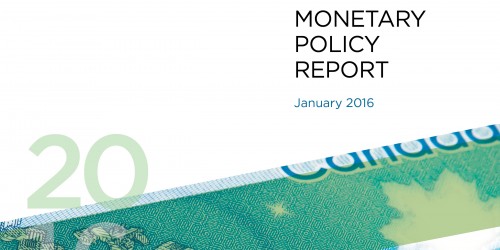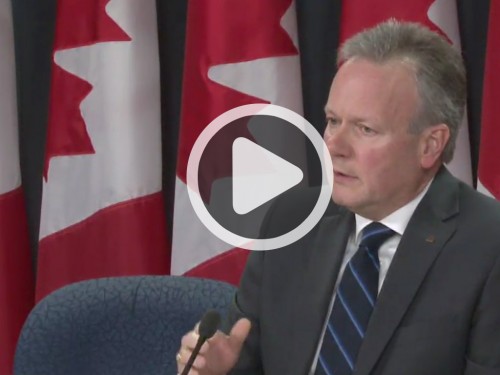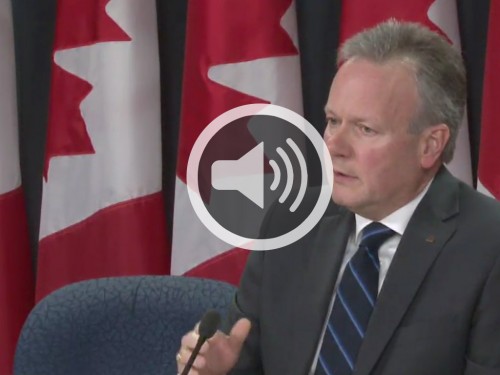Monetary Policy Report Press Conference Opening Statement
Good morning, and thank you for coming today. Let me begin as usual with a few remarks around the issues that were most important to the Governing Council’s deliberations.
At the global level, 2015 was a little disappointing as the world dealt with diverging economic prospects and shifting terms of trade, but we expect gradual strengthening to resume in 2016. There has been considerable attention paid to recent developments in China, and this has added to volatility in global financial and commodity markets. However, it was Governing Council’s judgment that China will remain on its transition to a more balanced and sustainable growth path, from around 7 per cent annual growth to around 6 per cent.
Volatility in equity markets is, of course, not always a reflection of weak economic fundamentals. Nevertheless, the global equity-market correction may inject a further measure of caution into business decision making. Our global outlook remains positive, albeit cautiously so. Governing Council believes that the U.S. economy remains solid—the fourth quarter of 2015 was soft, but we believe this to be largely temporary for reasons we discuss in the Monetary Policy Report (MPR). Solid fundamentals, including strong employment gains, high consumer confidence and very strong investment outside the energy sector should see U.S. growth return to close to 2 1/2 per cent this year.
Not coincidentally, the Canadian economy appears to have stalled in the fourth quarter. There were some temporary factors at work for us, too, but the main issue was slower exports to the U.S. We expect growth to pick up to 1 per cent in the first quarter, along with the U.S., and then to move back above 2 per cent for the remainder of the year. Our new annual growth forecast for 2016 is 1.4 per cent; however, much of the downward revision in that figure is because of the weakness we saw in the final quarter of last year. On a fourth-quarter-over-fourth-quarter basis, growth for 2016 is projected to be a more solid 1.9 per cent.
In its deliberations, Governing Council focused mainly on the implications of lower prices for oil and other commodities for Canada and for monetary policy. This shock is complex because it sets in motion several forces: Canada earns less income from the rest of the world, our resource sector begins to shrink, the Canadian dollar depreciates, and the non-resource sector expands.
That is a lot of structural change. We are publishing a discussion paper today that offers additional analysis of this process. One implication is that it may take up to three years for the full economic impact to be felt, and even longer for all of the structural adjustments to take place.
Since our last MPR in October, the magnitude of this shock has clearly grown. Firms are still cutting investment spending, but we had already built most of the downside into our October MPR. The bigger change in our projection comes from the impact of even lower oil prices on Canadian income. As one measure of this change, our base case forecast suggests that it will now take longer to absorb the economy’s excess capacity—probably until late 2017, perhaps later. This is a significant setback compared with our October projection. Nevertheless, we expect growth to exceed potential through most of 2016 and 2017, so the gap should be substantially closed by late 2017.
When considering our policy options, Governing Council needed to bear in mind that our base case forecast omits a key consideration; namely, the government’s intention to introduce fiscal measures to stimulate the economy. Our convention is not to guess about these things, but to incorporate actual announcements. Suffice it to say that were we to incorporate a degree of new fiscal stimulus in this projection today the output gap would close sooner than in our base case, but how much sooner would depend on the scale and nature of the fiscal measures.
It is fair to say, therefore, that our deliberations began with a bias toward further monetary easing. The likelihood of new fiscal stimulus was an important consideration—others included:
First, the Canadian dollar has declined significantly since October, which means that the non-resource sectors of our economy are receiving considerably more stimulus than we projected then. Let’s remember that it typically takes up to two years for the full effect of a lower dollar to be felt.
Second, past exchange rate depreciation is already adding around 1 percentage point to our inflation rate. This is a temporary effect, and is currently being offset by lower fuel prices—another temporary effect. However, we must be mindful of the risk that a further rapid depreciation could push overall inflation higher relatively quickly. Even if this is temporary, it might influence inflation expectations.
Governing Council continues to see the underlying trend in inflation as somewhat below 2 per cent, given the persistent, and recently widening, slack in the economy. Inflation expectations remain well anchored at about 2 per cent. With the economy expected to resume above-potential growth in the near term, our expectation is that inflation will converge on 2 per cent as the output gap closes and the temporary effects of low oil prices and past exchange rate depreciation dissipate.
To summarize, the drop in oil and other commodity prices constitutes a significant setback for the Canadian economy, and has set in motion a protracted adjustment process. That will mean the continuation of a two-track economy, with the resource sector shrinking and other sectors picking up speed, all facilitated by a lower Canadian dollar and supported by very stimulative monetary policy.
While that adjustment process sounds mechanical, in fact, it is personal. It is disrupting the lives of many Canadians, whether through job losses or through higher prices for imported goods. Monetary and fiscal policies can help to buffer some of these effects, and help speed up the process by fostering growth in other sectors of the economy, but the adjustment must ultimately take place. Although the economy may grow more slowly than we would like during that transition, it can still achieve above-potential growth and absorb its excess capacity. We are encouraged by the resilience and flexibility of the Canadian economy as signs of adjustment are already evident.
Meanwhile, the world economy is expected to strengthen on the back of stimulative policies and low energy costs, the U.S. economy is on a solid track and our past monetary actions continue to produce results. These are all positives that should be recognized. In this context, as complex and uncertain as our situation is, Governing Council decided that the current stance of monetary policy remains appropriate.
Let me conclude by saying publicly “au revoir” to our good friend and colleague, Deputy Governor Agathe Côté, who served the Bank with distinction for over 32 years. Her official end-date is January 31st. We will miss having her in Governing Council, and wish her well.
With that, I’ll now be happy to take your questions.


